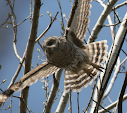
The juvenile Red-tail has some characteristics to help identify it, but also make it a bit tougher to distinguish from other raptors. If you can see a pale iris in the field or in an image you have a very good indicator. Unfortunately, birds being wild and not always distracted with their supper when we find them, an eye look is not always ensured.
This individual was cooperative enough to give me looks from most angles. With Red-tails a look from behind is often helpful. Three clues are visible on this bird. First, the head is lightly colored, but does have some dark on it. Second, the scapulars (feathers that cover the shoulders of a bird), form a white "V" pattern on the back. That one is nice because it can be easy to spot from a distance, but I find that I still don't trust it, as many hawks can have varying amounts and patterns of white on the back. I am sure that with time I will trust that one more, but for now I use it as a piece of the puzzle. Third, check out the tail! It has uniform gray-black banding, with a wider black tip.

This Hawk, a light-morph, has other traits when seen from the front that can help add to a composite identification. The breast and thighs are both mostly white, and there is a distinct white browline on the face.
Also, the legs are not feathered to the feet. On a sighting like this that is a big help, but if the bird is simply perching and observing or sleeping the bare legs may be covered by the body feathers, making for a more frustrating look. A bit of stretched flesh below - but for a raptor that is one of the most beautiful sights in the world.

Ok, enough of the feast. A parting shot of the pair of Northern Flickers who were willing to brave the breeze at lunchtime.




The first photo is especially nice. Love that bird!
ReplyDelete